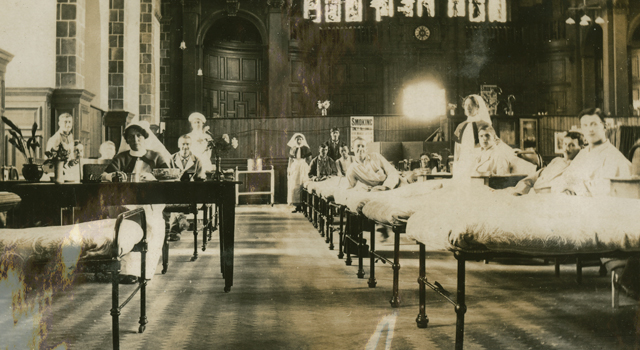Articles

No Comments
By Voices
On 17, Aug 2015 | No Comments | In Cities | By Voices
The Role of Sphagnum Moss in the Great War
Adrian Blackledge, University of Birmingham
During the Great War sphagnum moss played an important part as a substitute for cotton gauze dressings, as it was found to absorb liquids about three times more quickly than cotton, retain liquids much better, and distribute the liquids more uniformly. It was cooler, softer, and less irritating than cotton, and could be produced more rapidly and more cheaply.
![University of Birmingham Great Hall [Ref: Library of Birmingham: Misc Photos WW1]](http://www.voicesofwarandpeace.org/wp-content/uploads/2015/08/misc-photos-ww1-gs-850.jpg) From 1915-1918 sphagnum moss was collected from the mires and bogs of Dartmoor. Cleaned, dried and packed in processing centres such as Princetown, the moss was then distributed to local centres where dressings were made into muslin bags and sent to military hospitals. In the Dartmoor village of Widecombe a 15 inch shell commemorates the contribution of the village’s women and children as collectors of the moss from the moor.
From 1915-1918 sphagnum moss was collected from the mires and bogs of Dartmoor. Cleaned, dried and packed in processing centres such as Princetown, the moss was then distributed to local centres where dressings were made into muslin bags and sent to military hospitals. In the Dartmoor village of Widecombe a 15 inch shell commemorates the contribution of the village’s women and children as collectors of the moss from the moor.
The Great Hall at University of Birmingham was used as the 1st Southern General Hospital from 1914-1918, with the first wounded soldiers arriving on 1 September 1914, and 1,000 beds provided by early 1915. Over the course of the war 130,000 patients were admitted.
The following poem is in three parts. In Part 1 a young couple strolls on Dartmoor; in Part 2 a young woman collects sphagnum moss on the moor; in Part 3 a seriously wounded soldier is in the care of the 1st Southern General Hospital.
Sphagnum Moss
“Whereas a pad of absorbent cotton allows sanious discharges to penetrate and pass beyond to the bed clothes, a pad of sphagnum absorbs and holds up the discharges”
W. Cathcart, Senior Surgeon, Edinburgh Infirmary, June 16th, 1916.
i
Lights flicker into life
at Widecombe-in-the-Moor
and they will have to hustleif they are to make the station
at the end of a timeless day
in August 1916.But they are young and think not
of the Exeter train;
instead they will lay downon cushions of bog moss
wrap themselves in heather
and watch the stars stroll bywinking as they go.
ii
Barefoot in bogs and mires
she breaks her back nine hours a day
in wind, sleet, or rain.Jute sacks slung front and rear
chafe the skin of her neck
until she starts to bleed.Wet moss soaks her to the bone
and she can no more feel her legs
but she will do a hundred sacksbefore the sun sinks over Yes Tor
and she must push the trolley
down to the waiting truckssinging with the girls as she goes.
iii
This is some cathedral
to die in: sunlight
on stained glass, arched cloisterslike a real cathedral.
There’s a Catholic priest
in a black, three-peaked hat.Kyrie eleison.
Stench of gangrene and piss.
A nurse in a white apronreplaces his drenched dressing
with dog-toothed sphagnum moss.
It’s magic, she says, magicto sweeten you as you go.



Submit a Comment